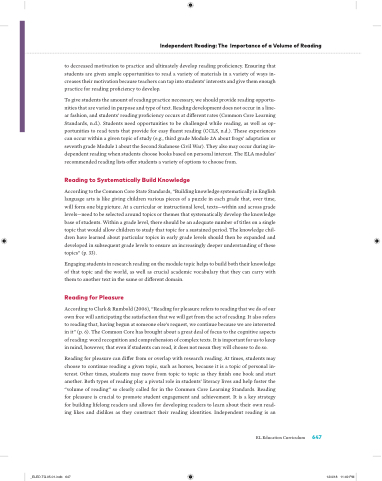Page 671 - EL Grade 5 Teacher Guide
P. 671
Independent Reading: The Importance of a Volume of Reading
to decreased motivation to practice and ultimately develop reading pro ciency. Ensuring that students are given ample opportunities to read a variety of materials in a variety of ways in- creases their motivation because teachers can tap into students’ interests and give them enough practice for reading pro ciency to develop.
To give students the amount of reading practice necessary, we should provide reading opportu- nities that are varied in purpose and type of text. Reading development does not occur in a line- ar fashion, and students’ reading pro ciency occurs at di erent rates (Common Core Learning Standards, n.d.). Students need opportunities to be challenged while reading, as well as op- portunities to read texts that provide for easy uent reading (CCLS, n.d.). These experiences can occur within a given topic of study (e.g., third grade Module 2A about frogs’ adaptation or seventh grade Module 1 about the Second Sudanese Civil War). They also may occur during in- dependent reading when students choose books based on personal interest. The ELA modules’ recommended reading lists o er students a variety of options to choose from.
Reading to Sy ematically Build Knowledge
According to the Common Core State Standards, “Building knowledge systematically in English language arts is like giving children various pieces of a puzzle in each grade that, over time, will form one big picture. At a curricular or instructional level, texts—within and across grade levels—need to be selected around topics or themes that systematically develop the knowledge base of students. Within a grade level, there should be an adequate number of titles on a single topic that would allow children to study that topic for a sustained period. The knowledge chil- dren have learned about particular topics in early grade levels should then be expanded and developed in subsequent grade levels to ensure an increasingly deeper understanding of these topics” (p. 33).
Engaging students in research reading on the module topic helps to build both their knowledge of that topic and the world, as well as crucial academic vocabulary that they can carry with them to another text in the same or di erent domain.
Reading for Pleasure
According to Clark & Rumbold (2006), “Reading for pleasure refers to reading that we do of our own free will anticipating the satisfaction that we will get from the act of reading. It also refers to reading that, having begun at someone else’s request, we continue because we are interested in it” (p. 6). The Common Core has brought about a great deal of focus to the cognitive aspects of reading: word recognition and comprehension of complex texts. It is important for us to keep in mind, however, that even if students can read, it does not mean they will choose to do so.
Reading for pleasure can di er from or overlap with research reading. At times, students may choose to continue reading a given topic, such as horses, because it is a topic of personal in- terest. Other times, students may move from topic to topic as they nish one book and start another. Both types of reading play a pivotal role in students’ literacy lives and help foster the “volume of reading” so clearly called for in the Common Core Learning Standards. Reading for pleasure is crucial to promote student engagement and achievement. It is a key strategy for building lifelong readers and allows for developing readers to learn about their own read- ing likes and dislikes as they construct their reading identities. Independent reading is an
EL Education Curriculum 647
_ELED.TG.05.01.indb 647
12/4/18 11:49 PM


